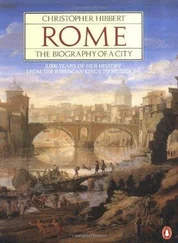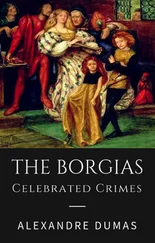On May 23, the day the news of the wedding arrived in Rome, the pope declared an evening of celebrations. That night Rome was en fête . Fireworks exploded in the sky; torches burned throughout the night; ‘bonfires were lit as a sign of joy in the city,’ recorded Burchard, who reported that even Lucrezia had lit her own fire, despite the fact that the French alliance spelled imminent disaster for her husband, Alfonso of Aragon, and for her sister-in-law Sancia. For Burchard, too, the marriage did not bode well: ‘It was in reality a great dishonour, a source of great shame for His Holiness and for the Holy See.’
The pope, however, was hugely relieved. He admitted to one foreign envoy that he had entertained real doubts as to the marriage ever taking place, but now that it had done so he was delighted, and, whereas he used to speak ill of France, he was ‘now all French because of the love the King of France had shown towards his Duke.’ So anxious and impatient of late, he was contented once more and raised no objection when asked to pay the 30,000 ducats required in France toward the cost of accommodating and entertaining his son during his stay there. The benefits that he was expecting from this alliance with France would bring him, and particularly his son, advantages that would far outweigh this sum of money.
‘AUT CAESAR AUT NIHIL’
IT WAS IN THE MIDDLE of July 1499 that news reached Rome that the king of France was gathering his troops in Lyons ready for the invasion of Italy and the military campaign to enforce his claims to Milan and Naples. Knowing what was in store for his family, Cardinal Ascanio Sforza fled the city to join his brother, Duke Ludovico. The pope’s son-in-law, Alfonso of Aragon, left on August 2, riding toward Naples, much to the misery of Lucrezia; the young man, according to the Venetian ambassador, had ‘deserted his wife who has been with child for six months and she cries constantly.’ A few days later, Alexander VI sent his reluctant daughter-in-law Sancia off to join her brother in Naples and, on August 8, dispatched their spouses, Lucrezia and Jofrè, north to Spoleto, a town in the Apennines, to which he now appointed the nineteen-year-old Lucrezia as governor, an unusual appointment but one that confirmed the respect the pope had for his daughter’s abilities and the trust he placed in her loyalty — it was an appointment that would have been conventional for a son. Out of respect for her delicate condition, he equipped her with a litter, which was decorated inside with white and crimson satin, to ease what would be an extremely uncomfortable journey up into the hills in the harsh summer heat.
Cesare, meanwhile, had taken leave of his new bride in early July, just two months after his wedding, and ridden south from Blois to join the French troops massing at Lyons. With an army of six thousand cavalry, one company of which was under Cesare’s command, and seventeen thousand infantry, Louis XII was optimistic about his chances of conquering the prosperous duchy of Milan. He declined, however, to lead the troops himself, preferring instead to follow the old French tradition whereby a king without a direct male heir should remain in France.
By the end of the month, the French army had crossed the Alps, negotiating the passes with ease in the midsummer heat, and were now encamped on the Po plain. Alessandria capitulated after a short siege, and several other towns, mindful of the price they would pay for resistance, chose to surrender peacefully. On September 2 Duke Ludovico Sforza, who was not popular in Milan and was suspected by many of having poisoned his nephew to acquire his title, fled the city. The Milanese, unwilling to suffer as Alessandria had done, opened their gates to the French invaders. A month later, on Sunday, October 6, Louis XII made his formal entry into the city, hailed as ‘King of the Franks, Duke of Milan.’
Leading the cavalcade was an armed guard of six hundred soldiers, followed by Louis XII’s general carrying the gilded baton. The French king rode a bay charger caparisoned in gold and clattered triumphantly through the city streets, which had been hung with white awnings emblazoned with the French fleur-de-lis. Also taking part in the procession were Cesare Borgia and Cardinal Giuliano della Rovere, as well as the ambassadors of Venice, Spain, Genoa, Florence, Ferrara, and Mantua. The cavalcade, however, was not greeted with as much enthusiasm as Louis XII had hoped; one Venetian eyewitness reported that he heard only a few shouting, ‘France! France!’
The once-proud Sforza dynasty had collapsed into ruins. When Louis XII opened the treasure chests in the Castello Sforzesco, Ludovico’s massive fortress, he found them empty — Ludovico had managed to escape with a fortune in gold and jewels. Leonardo’s famous fresco of The Last Supper in the convent of Santa Maria delle Grazie, to which the king made a special visit, accompanied by Cesare, had already begun to flake off the walls of the refectory, and, saddest of all, Leonardo’s clay model of a horse, intended by Ludovico Sforza for a bronze equestrian statue of his father, Francesco, had symbolically crumbled under the shots of the French soldiers who had used it for target practice.
With the French conquest of Milan accomplished, Cesare had fulfilled his part of the bargain that his father, the pope, had reached with the king of France, and it was time for Louis XII to honour the promise he had made to Cesare, to provide him with a contingent of French troops to fight under the duke’s orders. The arrival of the French army in Italy provided Alexander VI and his son with the pretext they needed to establish a state for Cesare in northern Italy, using the thinly disguised excuse of the need to reassert control of the Papal States to counter the strong French presence in the area.
The Papal States covered a large area in northern and central Italy, stretching down the Adriatic coast from Bologna and Ravenna to Ancona and across the Apennines into the Tiber valley to include Lazio and the countryside around Rome. It was a mosaic of small states, each belonging to the church, bordered to the north by the duchy of Ferrara and to the south by that of Urbino, both papal fiefs, and to the west by the independent Republic of Florence. Some of these states were administered directly from Rome, like Spoleto, where Lucrezia was governor; others were ruled by quasi-autonomous lords, known as vicars.
As Niccolò Machiavelli observed without excessive exaggeration, these lands were ‘a nursery of all the worst crimes, of outbreaks of rapine and murder, resulting from the wickedness of local lords and not, as these lords maintained, from the disposition of their subjects. For these lords were poor, yet endeavouring to live as though they were rich, they resorted to innumerable cruelties… and passed laws prohibiting certain acts only to give occasion for breaking them… and punishing offenders by imposing heavy fines which they collected.’ The area might have been intermittently lawless, but much of it was highly fertile, especially in the north, where agriculture flourished on the alluvial soils of the Po plain. It was also of enormous strategic importance, offering the possibility, once firmly unified, of a state as considerable as those of Naples, Venice, or Florence. It was this area that Alexander VI intended, with the help of the French, to unite into a duchy for his son.
In October, shortly after Louis XII’s triumphant entry into Milan, Alexander VI announced that ‘the vicars of Rimini, Pesaro, Imola, Forlì, Camerino and Faenza, as well as the Duke of Urbino, feudatories of the Church in Rome, have failed to pay their annual census to the Apostolic Chamber,’ according to Burchard’s report, ‘and so [the pope] has removed their titles and declared them forfeit.’ Burchard added that the city of Milan — by which he meant the new French government — had loaned 45,000 ducats to the pope to raise troops to retake these territories: ‘The Duke of Valence,’ he reported, ‘captain of these troops, has received this sum in the name of the Church.’
Читать дальше











